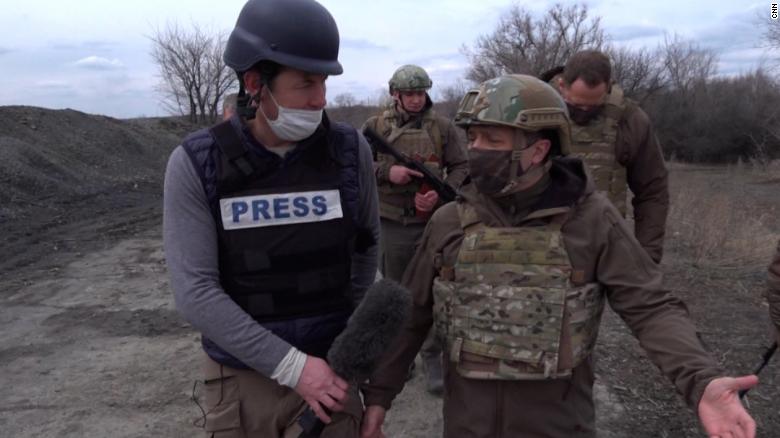CNN EXCLUSIVE
begin quote from:Ukraine's President runs for cover on front line against Russia
• Analysis: Bluff or not on Ukraine, Putin is playing with fire
• The bitter battle over Russia's lake that holds 23% of the world's freshwater
• The bitter battle over Russia's lake that holds 23% of the world's freshwater
Ukraine's President heads to the trenches as Russia masses its troops
Updated 8:39 AM ET, Mon April 12, 2021
On the front lines in eastern Ukraine (CNN)Ankle-deep in thick black sludge, Ukrainian President Volodymyr Zelensky moves stealthily with his troops in single file through the warren of trenches and tunnels that form the tense front lines in the east of his country.
It feels more like the early 20th century than a modern conflict, with tired, nervous soldiers gripping their rifles around him as they reach open ground, scanning the area for movement across no-mans-land.
They know snipers, likely trained by Russians, say Ukrainian officials are looking for a chance to fire. More than 20 of their comrades have been gunned down already this year.
It's eerily quiet with an occasional crack of a gunshot in the distance shattering the calm, keeping everybody on edge.
This area near Mariupol is a risky place for the President of a country to visit, but that doesn't stop Zelensky who granted CNN unprecedented access to his trip to the front lines, where he insists on going to the most forward positions.
"If I visit a military base, the guys at the very front will hear about it and think I forgot about them," Zelensky told CNN in exclusive comments over two days. "They need to know they have political support."
Zelensky, strapped into a camouflage flak jacket and helmet, has to sprint across the open ground with his presidential security to reach the trench cover.
With Russian troops massing on their side of the border with Ukraine, the US and its NATO allies declared political and military backing for Ukraine. Zelensky urged them to bolster their support.
New boiling point in long standoff
For years, the brutal conflict in eastern Ukraine, between government forces and Russian-backed separatists, has been locked in a tense standoff. Major combat, which cost thousands of lives since 2014, has given way to a grinding stalemate. Following the annexation of Crimea by Russia in 2014, fighting erupted in the neighboring Donbas region -- another mainly Russian speaking area of Ukraine with rebels demanding independence from Kiev.
But amid growing tensions with the United States and its Western allies, Russian forces have again been spotted on the move across the border sparking concerns the war may be reignited.
Cell phone video has emerged of Russian armored columns driving towards the Ukrainian frontier. Tanks and artillery guns have been seen being transported by rail. There's also been a build-up reported in Crimea.
In Moscow, the Kremlin says the troop movements are inside Russia, part of a planned military exercise and pose no threat.
But at the front lines, the Ukrainian President told CNN a Russian invasion is a very real possibility his country is bracing for.
"Of course. We know it, from 2014 we know it can be each day," he said.
"They are ready, but we are also ready because we are on our land and our territory," he told CNN.
Lt. Gen. Ruslan Khomchak, commander-in-chief of the Ukrainian armed forces, told CNN an estimated 50,000 Russian troops have now gathered across the Russian border and in Crimea. In addition, there are at least 35,000 Russian-backed separatists in rebel-held areas of Ukraine, he said.
Even before this current worrying build up in the number of troops at Moscow's command on Ukraine's doorstep, Zelensky called for the US to sell it weapons, such as Javelin anti-tank missiles. Those weapons have now been delivered, most notoriously in a phone conversation with then-President Donald Trump.
US Secretary of State Antony Blinken said Sunday that there are "real concerns" over Russia's action. On NBC's "Meet the Press," Blinken said, "The question is, 'Is Russia going to continue to act aggressively and recklessly?' If it does, the [US] President's been clear, there'll be costs, there'll be consequences."
CNN reported Friday that the US is considering sending warships into the Black Sea in the next few weeks in a show of support for Ukraine.
Lurching to the future
From the air, above the muddy trenches, the seemingly endless flatness of eastern Ukraine is punctuated by battered towns and the rusting industrial hulks of the Soviet-era factories that made this war-ravaged region Ukraine's economic backbone.
Military helicopters, deafening old MI-8s first developed during the Soviet era, painted in unnaturally vivid combat camouflage, fly fast and low over the countryside to avoid ground fire. Every few minutes they lurch upwards to leapfrog trees or electricity lines, then quickly plunge back down again within feet of the soil.
On board the aging presidential chopper, which retains a degree of well-worn comfort, Zelensky shouts above the engine noise of how the US is a "good friend" of Ukraine, but that President Biden "must do more," to deter Russia and help bring this conflict to an end.
More weapons, more money to fight, and, crucially, more support to join NATO, the Western military alliance where an attack on one member commits all to respond, he explained.
"If they [the US] see Ukraine in NATO, they have to say it directly, and do it. Not words," Zelensky told CNN.
But the chances of that are slim, amid concerns that moving Ukraine closer to NATO membership would provoke Moscow, possibly fueling a broader conflict.
"Maybe you are right," Zelensky responds.
"But what now is going on? What we do here? What do our people do here? They fight."
At the front line, Zelensky led a minute of silence for the fallen.
With or without NATO, this is his country's reality. Ukraine is at war.






















No comments:
Post a Comment